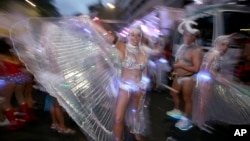A group of Aboriginal transgender women have traveled more than 3,000 kilometers to take part in Sydney’s world-famous Gay and Lesbian Mardi Gras. They have spent decades fighting for recognition within the indigenous community on the remote Tiwi Islands.
About 30 transgender women from the islands off the coast of Australia’s Northern Territory will march Saturday for the first time with thousands of other participants in outfits colored with glow-in-the-dark paint emblazoned with traditional patterns and totems.
Known as "sistagirls," the group’s trip has been financed through various fundraising campaigns. They bring to Sydney a story of struggle and defiance. It has taken the women many years to gain acceptance in their remote Indigenous communities, where attitudes have shifted slowly. Several of the women have committed suicide in the past.
Born a male, Simon Miller now identifies as a woman.
“[I] did not know about sistagirls until I was, like, 22. When I am [a] sistagirl, I feel like 100 percent true to me and I feel happy, you know, and when I am, like, dressing like a boy and that I feel, like, depressed and feels really awkward and uncomfortable,” Simon said.
Sydney’s gay and lesbian Mardi Gras began as a civil rights rally in the late 1970s. It was born out of solidarity for New York's Stonewall movement, and called for an end to discrimination against gays and lesbians.
The group has a loud political voice, as campaigners continue their efforts to persuade Australia’s leaders to legalize same-sex marriage.
Opponents of the march, including some Christian groups, have in the past described it as a “public parade of immorality and blasphemy."





